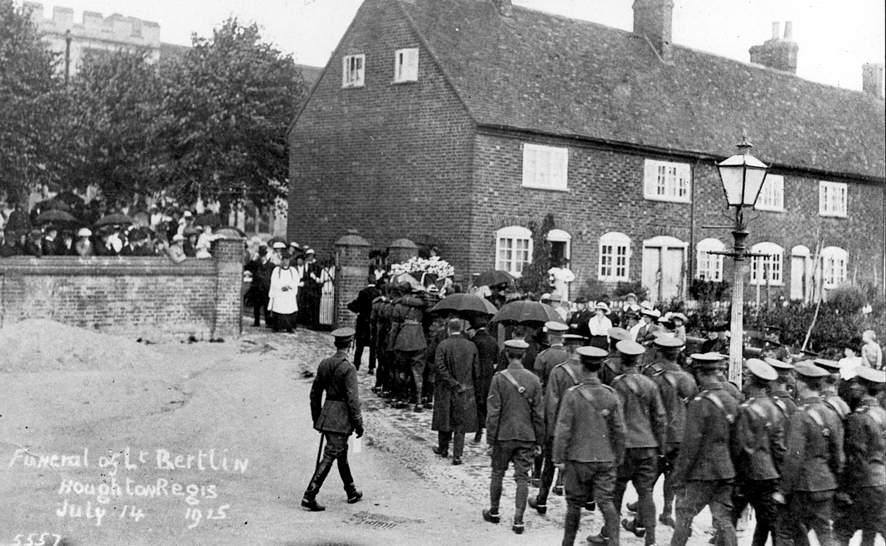
A terrible motor fatality occurred at Houghton Regis on Saturday afternoon [July 10th, 1915], involving the death of Second-Lieut Hugh Anthony Bertlin and serious injuries to Second-Lieut J. R. Smith, of the Royal Engineers, stationed at Houghton.
Lieut Bertlin was riding a motorcycle with Lieut Smith sitting on the carrier, with a view to visiting Luton. They had barely left the village when the cycle collided with a motorcar driven by Mr Frederick Percival Jones, automobile engineer, of Monserrat House, High Street North, Dunstable. Lieut Bertlin was picked up unconscious and his brother officer had sustained serious injury, and after first aid they were conveyed to Wardown Military Hospital.
Medical examination revealed a hopeless case as far as Lieut Bertlin was concerned, and his parents were summoned at once. These fears were confirmed for he never regained consciousness and passed away at 2 am on Monday morning. He had sustained a fracture of the base of the skull, severe scalp wounds and cuts and bruises on the body and face.
Lieut Smith is suffering from a fractured wrist and cuts and bruises on the face and body, but is making good progress.
Mr Jones was unhurt, but suffered as a result of the collision. He informed a Luton News reporter last night that he picked Lieut Bertlin up and drove him in his car to Houghton Hall.
An inquest into the death of Lieut Bertlin was opened by Mr Mark Whyley, the County Coroner, at the Courthouse on Tuesday.
Anthony Bertlin, civil engineer residing at Morgan House, Ealing Green, the father of the deceased, gave evidence of identification. He said his son's age was 24, and that he was resident in Canada when war broke out. He joined the Canadian Expeditionary Force in October and came to this country in March.
He was gazetted lieutenant in the Royal Engineers on April 10th, and had been stated at Houghton Regis 10 days before the accident. Witness received a wire on Saturday informing him of the accident, in consequence of which he came down to Luton, and at the Wardown Military Hospital saw his son, who was quite unconscious. Witness remained in the town and saw deceased again on Sunday morning, but he had not recovered consciousness. He was not present when deceased died..
His son had good sight, having read flag-signalling at two miles distance, and he had never complained of giddiness or faintness and was accustomed to rising a motorcycle.
The Coroner said that Lieut Smith would probably so far recovered from his injuries as to be able to given evidence a fortnight hence. He therefore proposed to adjourn the inquiry for a fortnight, and this the jury approved.
Houghton Regis, where the deceased officer was having his military course, was in mourning when his remains were interred with military honours in the village churchyard yesterday afternoon [July 14th]. The cortege moved from Houghton Hall through hundreds of troops at attention and salute, and afterwards through as many residents in the village.
At ten minutes to two B Company of the Royal Engineers marched out of the Hall gates and formed two dividing lines halfway up the road on the village green. Ten minutes later the bell in the Parish Church belfry was heard tolling, and as it ceased the band of the Royal Engineers, with draped drum and conducted by Bandmaster Alfred Graham, opened out on the road, and a firing party of 38 Engineers, headed by Lieut Leslie, Berkshire Regiment, all with arms reversed, passed up and fell in behind B Company,
At once the drums began to roll, and the band started on Chopin's 'Funeral March' as the mounted horses drew the gun carriage and coffin out of the circle of stately trees on the green. The coffin was covered with a Union Jack, and on this rested the deceased's sword, belt and hat in a cluster of beautiful flowers. Then came the four principal mourners. Before the procession left the green, B Company closed in behind these chief mourners, and a large number of officers brought up the rear.
As the cortege reached the lych gate at the church rain began to fall. The Vicar (the Rev F. C. Mahony), attended by Mr R. Cutler and Mr E. G. Blow (churchwardens), met the cortege at the gate and led the winding way to the grave under the shade of trees. Here, facing the deceased's relatives, members of the Headquarters Staff of the Royal Engineers, and with the firing party and band on the left and troops and public forming a square behind, he recited the last rites. This over, the band, who had played the 'Dead March' from 'Saul' on the route, rendered the hymn 'Abide With Me' and the words were sung by all assembled.
The music had barely died away when the firing party rattled three volleys out, a couple of young trumpeters sounded 'The Last Post' and the crowd dispersed.
The funeral arrangements were carried out by Messrs T. and E. Neville, Luton.
[At the resumed inquest on July 27th - despite a conflict of evidence on the position and speed of the vehicles involved and whether the car horn was sounded - the jury returned a verdict of accidental death on Second-Lieut Bertlin, with a recommendation that a 9ft high hedge that prevented a clear view of the road should be cut and laid and a warning post should be erected at the bend where the accident happened. Second-Lieut Smith was unable to attend to give evidence as it had subsequently been discovered he was also suffering from spinal injuries.]
[The Luton News: Thursday, July 15th, 1915]

